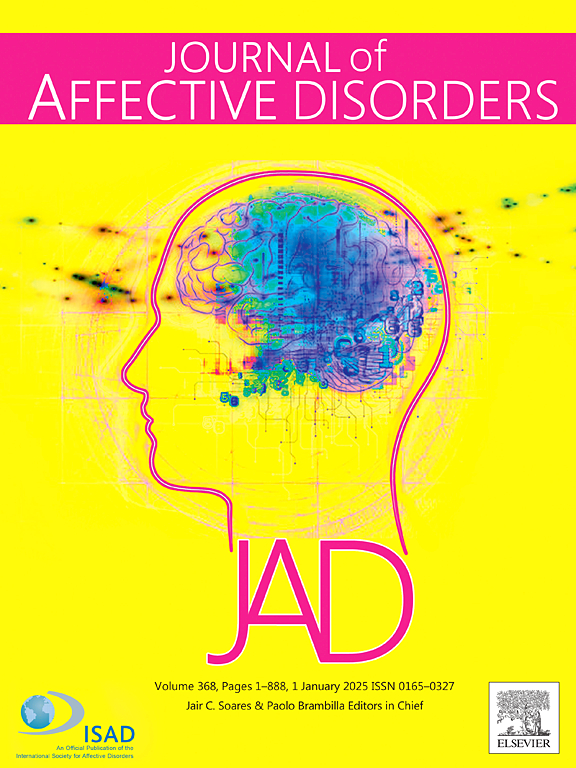围生期抑郁和焦虑介导的成人依恋类型对依恋关系的影响
IF 4.9
2区 医学
Q1 CLINICAL NEUROLOGY
引用次数: 0
摘要
很少有研究调查围产期妇女成人依恋类型、抑郁、焦虑和产前母婴/产后母婴依恋之间的关系,结果各不相同。我们考察了成人依恋类型对亲密关系的直接影响以及通过抑郁和焦虑产生的间接影响。方法在这项前瞻性观察性纵向队列研究中,从新泻县34家产科机构招募1897名日本围产期妇女。在T1(妊娠早期)评估成人依恋,在T1、T2(妊娠晚期)和T3(产后)评估抑郁/焦虑和依恋。本研究采用平行过程潜在生长曲线模型,考察了T1期成人依恋类型对围生期依恋的直接影响,以及抑郁和焦虑在三个时间点上的中介作用。结果成人依恋对亲子关系发展轨迹无直接影响。然而,我们发现了显著的间接效应,表明成人依恋类型通过影响抑郁和焦虑的发展轨迹来影响依恋的初始水平和变化,每种中介作用不同。模型拟合良好,可以接受。局限性:本研究的局限性在于依赖于自我报告测量,地理上的样本限制,以及缺乏长期随访。结论围生期抑郁和焦虑介导了成人依恋类型对依恋关系的影响。早期筛查和干预与母亲对其浪漫伴侣的依恋相关的抑郁和焦虑症状对于防止关系困难至关重要。本文章由计算机程序翻译,如有差异,请以英文原文为准。
Impact of adult attachment style on bonding mediated by depression and anxiety across the perinatal period
Background
Few studies have investigated relationships among adult attachment style, depression, anxiety, and prenatal mother-to-fetus/postnatal mother-to-infant bonding in perinatal women, with varied findings. We examined the direct effects of adult attachment style on bonding as well as indirect effects via depression and anxiety.
Methods
In this prospective observational, longitudinal cohort study, 1897 Japanese perinatal women were recruited from 34 obstetric institutions in Niigata Prefecture. Adult attachment was assessed at T1 (early pregnancy), with depression/anxiety and bonding assessed at T1, T2 (late pregnancy), and T3 (postpartum). We used parallel process latent growth curve modeling to examine direct effects of the T1 adult attachment style on bonding across the perinatal period, as well as the mediating roles of depression and anxiety over three time points.
Results
No significant direct effects of adult attachment on bonding trajectories were observed. However, significant indirect effects were found, suggesting that adult attachment style influenced both the initial levels and change in bonding via its impact on the developmental trajectories of both depression and anxiety, with distinct roles for each mediator. The model fit was good to acceptable.
Limitations
This study was limited by reliance on self-report measures, geographically restricted samples, and the absence of long-term follow-up.
Conclusion
We found that the impact of adult attachment style on bonding was mediated by depression and anxiety across the perinatal period. Early screening and intervention for depressive and anxiety symptoms related to the mother's attachment toward her romantic partner is essential to prevent bonding difficulties.
求助全文
通过发布文献求助,成功后即可免费获取论文全文。
去求助
来源期刊

Journal of affective disorders
医学-精神病学
CiteScore
10.90
自引率
6.10%
发文量
1319
审稿时长
9.3 weeks
期刊介绍:
The Journal of Affective Disorders publishes papers concerned with affective disorders in the widest sense: depression, mania, mood spectrum, emotions and personality, anxiety and stress. It is interdisciplinary and aims to bring together different approaches for a diverse readership. Top quality papers will be accepted dealing with any aspect of affective disorders, including neuroimaging, cognitive neurosciences, genetics, molecular biology, experimental and clinical neurosciences, pharmacology, neuroimmunoendocrinology, intervention and treatment trials.
 求助内容:
求助内容: 应助结果提醒方式:
应助结果提醒方式:


